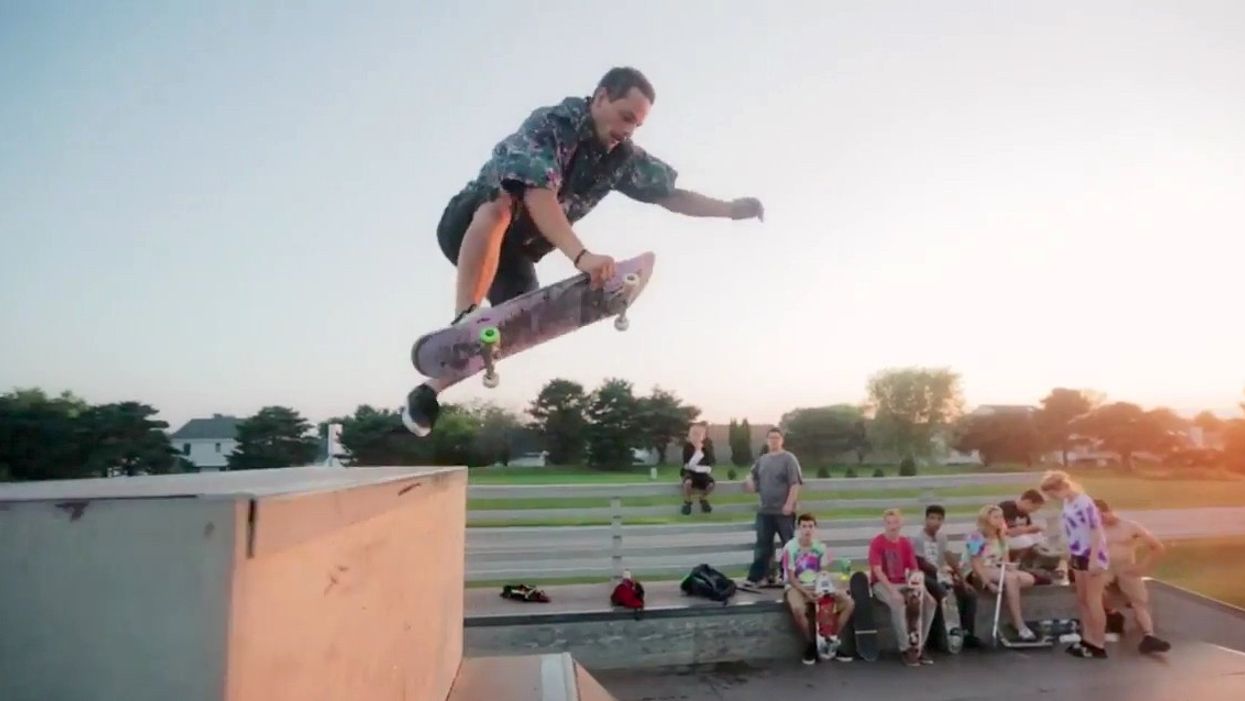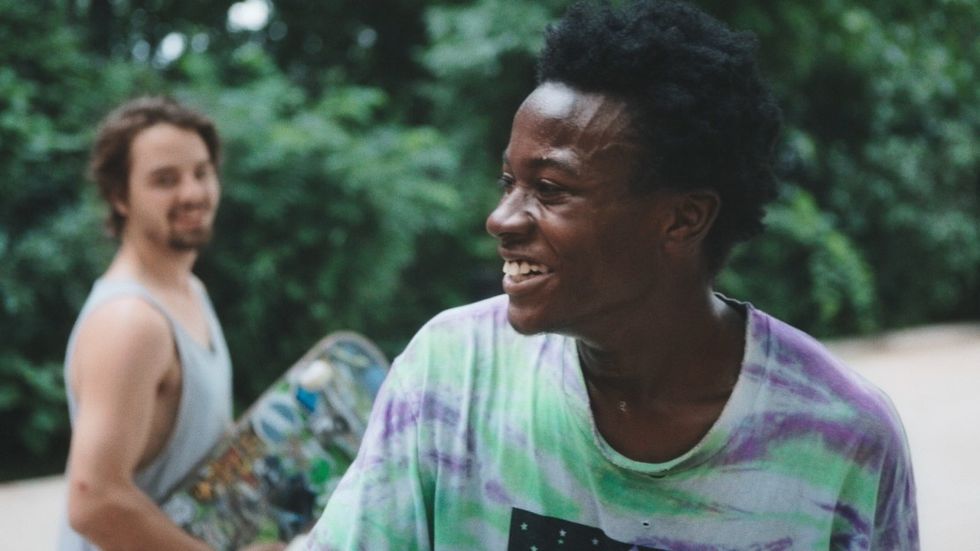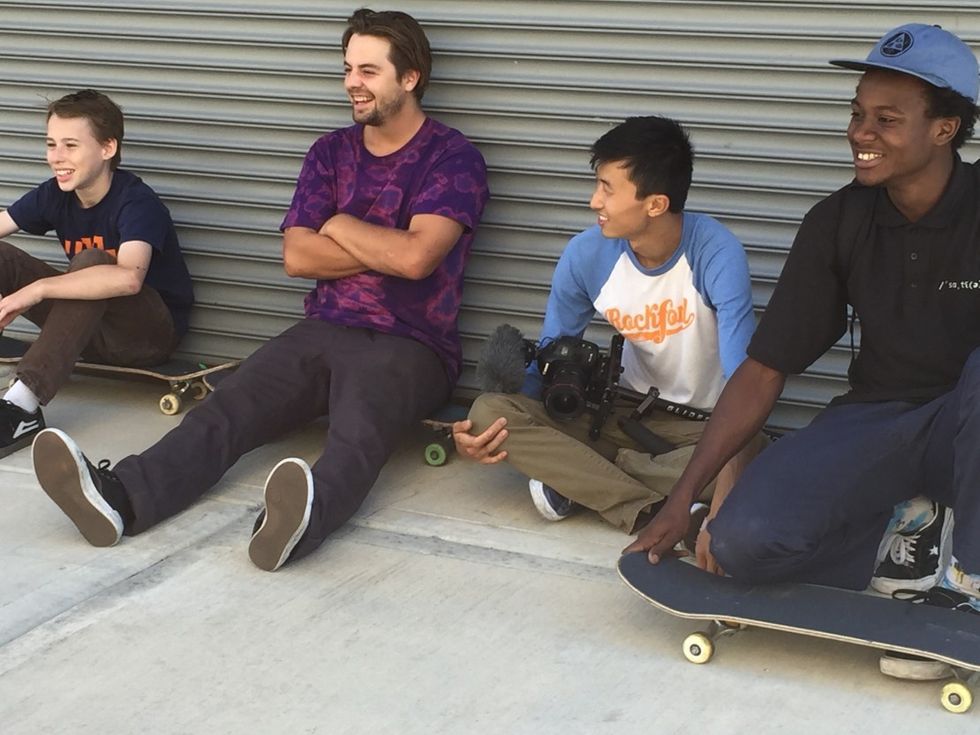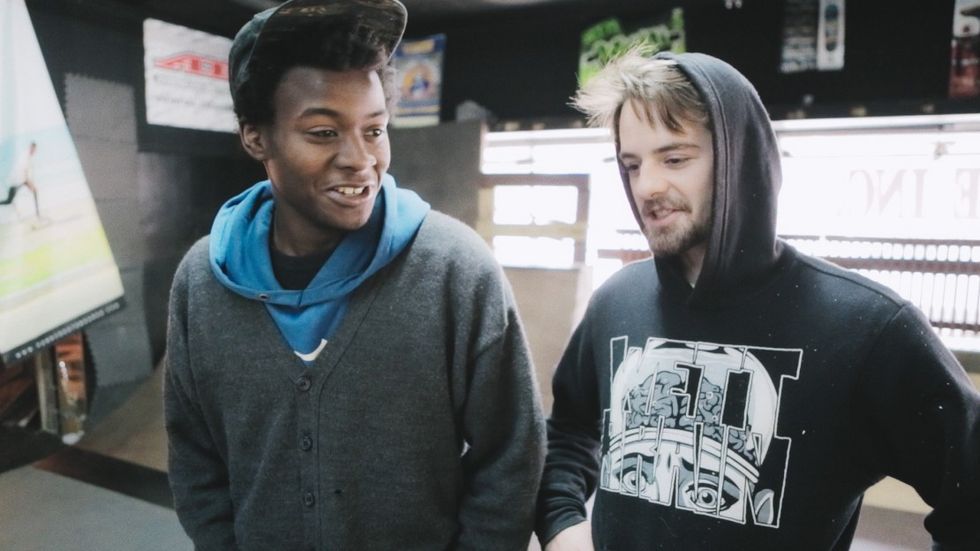'Minding the Gap': How Bing Liu Turned 12 Years of Skate Footage into the Year's Most Heartfelt Doc
"I used to just love making things perfect because that's how I was trained...None of that matters."

As a rule, I almost never make filmmaker interviews about myself. But, then again, there are rarely films that ring so true to my own life as does the heartfelt and beautifully crafted Minding the Gap. Like director Bing Liu, I was raised in “Rust Belt” America and hung out with a group of skateboarders who didn’t always fit in with the mainstream of our communities. And we both became documentary filmmakers. Unlike me, Liu has combined the two into a moving portrait of teenage America and a reminder that there’s often more to young people than what appears on the surface.
Though the particular details mirrored some of those in my own life, the film’s themes will likely resonate with anyone who has been a teenager, and you will love its multi-dimensional characters—despite their flaws—because the filmmaker so clearly does. Crafted from over 12 years of footage, Liu documents the coming-of-age of two skateboarding friends, Kiere and Zack. And yes, there’s plenty of sweet skating footage, but the story poignantly takes on race, class, and the cyclical nature of abuse.
“I never really saw a career in film as a viable thing. I thought making films was just what I did.”
Minding the Gap strikes a unique balance between transparency about its own making (In one scene, Liu is asked “Is this where I pretend you’re not here or where we talk the whole time?”) but lack of self-consciousness about looking cool. On the contrary, the filmmaker exposes some of the most difficult aspects of his friends’ personalities as he wrestles with them himself, crescendoing in an emotionally wholloping scene where he gently but directly confronts his own mother about abuse that took place in their household.
Having premiered at Sundance 2018, I spoke with Liu before the film’s theatrical and Hulu release about building his own rig to shoot smooth skateboarding shots, what he learned from over 30 feedback screenings, and much more.
NFS: Watching your film felt very nostalgic for me and I was thinking about how when I was young, filming and photographing everything was for the “weird, arty kids.” Now, everybody films everything. What’s your relationship with that idea?
Liu: I feel like I'm in the older cohort of the millennial generation and I didn't really grow up with smartphones or Apple computers with Photo Booth and now a lot of people are like video blogging, so I guess my point is I think younger kids these days are shooting for a different purpose. They're shooting to expose themselves. They're shooting to try to connect with other people. I think the aspect of young people using the camera to explore other people is a more artsy sort of thing. I feel like I belonged to that more artsy subculture growing up I feel like it was even weirder back then because the cameras weren't any bigger than in general.
NFS: How did you develop your unconventional aesthetics over time, starting from such a young age?
Liu: It was a mix of just emulating other creators and films that I was watching and also just going online and learning. By the time I was 16, I had a camera that I could set exposure and color temperature and with ND filters on it. By the time I was 17, I had a 24p camera and I was building my own dollies, so it was sort of just like exploring and emulation of what was happening at the time, which was a mix of the internet connecting more people, and also the DIY-style filmmaking that was growing with the advent of DSLR shooting video. I never really saw a career in film as a viable thing. I thought making films was just what I did.
"The Glidecam was freeing because you can run down stairs when you get good enough at it, and even jump over things with the cameras."
NFS: How did you transition to realizing that you could actually do this professionally?
Liu: It was when I got a job as a PA when I was 19 and I was like, “Oh, I can get paid $50 a day to like fetch coffee and carry heavy camera cases around for 14 hours.” It was less about the $50 and more about the “Oh, you can do this.”
NFS: That's what we're always telling people who want to break into the business: just get on set.
Liu: Yeah, I didn't go to film school, because everybody that I worked with in film was like: if you go to school. don't go to school for film, and so I went to school for literature.
NFS: So you could develop a sense of story and storytelling through literature?
Liu: I actually studied more the theoretical, like criticism and rhetoric, so a big takeaway from school was that you can deconstruct everything and everything is constructed and there's no truth, you know?

Liu: I'd been working on these high-end wedding videos with a camera system when I was in my early 20s and some of them had Steadicam operators on them and other ones they used just a Glidecam and it produced a similar effect.
Then as I went on to work in bigger productions with Steadicam operators, I learned the physics of Steadicam and I realized that Glidecam is the same physics, but just a much more crude and cheaper tool, so I decided to try to do it for skateboarding. It took me like at least a year to get intuitive with it to get to the point where I didn't have to think about it, but then once that happened, it let me follow people in such a different way and at eye level, so that felt more about the human perspective than about the board’s perspective.
I ran on foot mostly except for those times—like in that opening sequence—where I'm like, okay, they're gonna skate a quarter mile, I'm not gonna run a quarter mile. I'm gonna jump on a board that has wheels, but for shorter stuff it was just so much more freeing actually because you can run down stairs when you get good enough at it, and even jump over things with the cameras.
"A lot of people thought or assumed that I used a Movi or a Ronin to get those skating images, but there's just no way that would work."
NFS: What were the mechanics of it? What was your build?
Liu: Well, I mean, I just did the Canon 5D with the smallest RODE mic with the ⅛ inch plug. And then a 16 to 35 [lens], but because it was a full frame sensor, that 16 really feels up close and personal. Then I used to use this brace on my arm to help with the gimbal, to help hold the weight of it, but eventually, I got rid of even more weight from the bottom, and it just became such a run and gun package. I could fold it into three parts and put it in my backpack.
At the time, Movi was just coming out with their rig and like every commercial and TV show and movie you saw wanted to use this. I was assisting a lot and building those Movi packages in prep and I just realized this is so cumbersome. One Steadicam operator can do this job, but now all of a sudden you need like a Movi tech and two operators to work this one thing and it still doesn't have the same human responsiveness as a Steadicam. A lot of people thought or assumed that I used a Movi or a Ronin to get those skating images, but there's just no way that would work.
NFS: What are the most important principles of cinematography for you, regardless of what tech you're using?
Liu: I've worked in the freelance field for the past 10 years and I used to just love the beautification and making things perfect because that's how I was trained. That's what I was paid to do, you know, spending three hours just like waiting around for a wallpaper in the background to be adjusted just slightly to the right. But something that I've loved about my own way and working with Kartemquin Films is realizing that none of that matters.
The thing that matters the most is the story, so it's more about the purpose of your shots. I'm co-directing another film right now and it's with Josh Altman who co-edited Minding the Gap. He's basically spent his whole life in the editing room and so he's asking me questions about how to shoot and I told him: the two things [that matter] are frame sizes and perspective. Those are two things I want you to just remember.
All this technical stuff you'll learn along the way, but there are frame sizes that feel more psychologically pleasing to the eye. And it's based off of how Michaelangelo cut up the human body. If you stick with that then you can like realize like, yeah, that's why you never cut off people at the knees, that's why you never cut off people at the hip.

When you're shooting something, think about how it feels through a human in the room. Where are you standing? Because a lot of the time you'll be shooting something and it just has the feel of like, oh, this is just the camera person standing in the corner. It doesn't feel like perhaps there's somebody sitting on the other side of the room looking at the people they are with.
NFS: I was also really impressed with your use of sound in the film with a lot of J-cuts to lead into the next scene. What was your process for dealing with sound in post?
Liu: Yeah, I think it was probably just because when I first started editing skate videos at 14 or 15, J-cuts and L-cuts were just a cool thing and I never stopped really using them. I grew up in the era of Final Cut, but now that I'm more fluent with Avid I realize like, oh, it's actually much harder to do J-cuts and L-cuts. It's easier when you're not in Avid to just make your edit decisions and then later go back in if you want to do J-cuts or L-cuts.
In terms of the music, since the beginning, since I was a teenager I was using like [female-fronted indie pop band] Cat Power in my skate videos. I always thought of skateboarding as more emotional and spiritual and feminine than people outside of skateboarding realize. It was an extension of that as well. A lot of the temp tracks that I used like I took from films like, Moonlight and the film Mustang. Yeah, just like the really sort of melodic like emotional, orchestral, type of score.
Then in terms of the sound design, I remember like doing things like leaving a lot of what you would usually clean up in a commercial spot, like leaving a lot of that in to make it feel more like real and speak more towards like the filmmaker's presence. Even leaving in a lot of panning away at the end of a cut, there was a purpose to it.
“I always thought of skateboarding as more emotional and spiritual and feminine than people outside of skateboarding realize.”
NFS: Since the film is so personal, how did you make some of the harder decisions in terms of “killing your darlings” or what to leave on the floor?
Liu: I sort of saw myself as a character more than myself. I think that was very true of the whole process of making the film. I feel like I'm not that attached. For example, after Sundance we did the TV cuts, so we had to take it down to 82 minutes and at the time it was 98 minutes. And I took it down to 82 minutes in one night.
NFS: What?!
Liu: Yeah because it's like you know you've gotta cut it down to time and then we'll worry about the emotions later, so I feel like once you understand the story you’re making it's like, okay, you can just use that part of your brain to focus on, well, what is the actual purpose of this character? Like, what are we building towards? What is the purpose of this scene? What is the purpose of this shot?
It was a process. I was cutting for years and years. I was cutting since I was shooting, so it's hard to sort of pinpoint how or where darlings got killed or anything. It didn’t happen through like minuscule, tiny losing shots here and there. It happened in like very big crash and burn methods, like, okay, we're gonna lost this whole character. Because I filmed so much and spread so wide since the beginning.

Liu: I think I learned the value of feedback screenings. I think one of the most enriching things is actually going to a lot of other people’s feedback screenings. There are some [Kartemquin] staff who are notorious for not holding back, and so in hearing the way people give notes and the way some filmmakers did or didn't read the room, I think that helped a lot.
I did a ton of feedback screenings for the film. Probably at least 30 over the course of the years. Some of them bigger, some of them for just a couple friends, but over time, that's what helped me get over the emotional hump that you alluded to earlier in terms of killing your darlings. After a while it was like, okay, I've heard so much feedback about Kiere’s story or how they feel about Zack, it's like I'm slowly understanding them outside of myself.
NFS: What advice do you have for other filmmakers who are interested in putting their own story on film?
Liu: For a long time, I just had that moment where Kiere and I commiserated about crying and that was from the first or second interview I did with him. That's when I realized like, “Oh, this is the guy I need to follow.” And other people in feedback screenings were like, “We want to know more about you, have you tried putting yourself in it?” And I just didn't want to make a film that was self-indulgent or navel-gazing.
It wasn't until [Zack’s girlfriend] Nina told me that Zack was abusive when all of a sudden my character kind of surfaced. Like, the filmmaker had a purpose and that was to try to get at their relationship and what happened and get at how complex it is. I think that's what made going into my backstory feel earned because, in understanding what happened to my character in his past, then all of a sudden you have a better understanding of why this filmmaker is making the decision they're making.
It's about remembering why you're putting yourself in the film and it goes with along with everything I’ve said in terms of just asking: what is the purpose of everything that you're putting in the film? What purpose does it serve?











